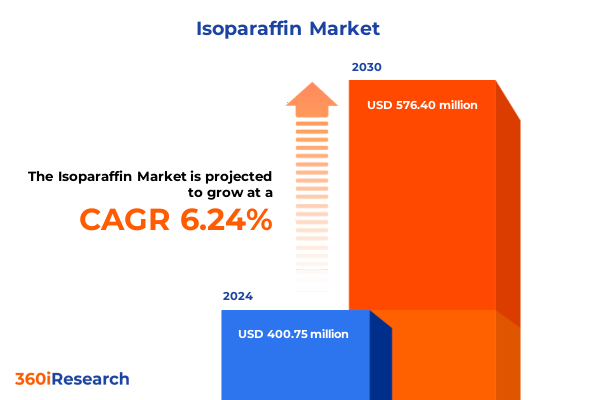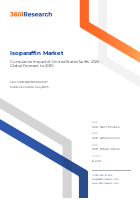The Isoparaffin Market size was estimated at USD 400.75 million in 2024 and expected to reach USD 425.24 million in 2025, at a CAGR 6.24% to reach USD 576.40 million by 2030.

Introduction to the Isoparaffin Market Ecosystem
Isoparaffins represent a versatile class of hydrocarbons characterized by highly branched molecular structures that deliver exceptional stability and performance across a range of industrial applications. From serving as carrier fluids in high-precision processes to enhancing sensory attributes in personal care formulations, these compounds have established themselves as indispensable building blocks in sectors as diverse as cosmetics, pharmaceuticals, paints, and beyond. In recent years, the market has witnessed a convergence of factors-heightened sustainability demands, stringent regulatory frameworks, and intensified competition-that have collectively propelled innovation and strategic realignments among key stakeholders.
This report unfolds against a backdrop of accelerating technological advancements, evolving end-use requirements, and shifting trade policies that redefine competitive advantages. By tracing the contours of emerging opportunities and potential challenges, it equips decision-makers with a holistic perspective on the forces currently shaping value creation within the isoparaffin ecosystem. As supply chains adapt and product portfolios refine, understanding these foundational dynamics has never been more critical for stakeholders aiming to secure leadership positions in a rapidly evolving landscape.
Throughout the following sections, we first explore the transformative shifts driving market evolution, then examine the impact of United States tariffs scheduled for 2025, before delving into detailed segmentation, regional trends, and competitive positioning. Finally, strategic recommendations designed to inform robust decision-making and sustainable growth strategies bring the narrative to a close.
Transformative Shifts Reshaping the Isoparaffin Landscape
Emerging sustainability mandates and the heightened scrutiny of environmental footprints have galvanized stakeholders to reengineer production pathways and embrace renewable feedstocks. Producers are increasingly exploring bio-derivatives and circular economy initiatives to reduce carbon intensity, while downstream formulators prioritize low-toxicity and readily biodegradable options to meet evolving regulatory standards.
Simultaneously, digitalization and advanced analytics are reshaping supply chain visibility, enabling real-time tracking of raw material flows and predictive maintenance for processing units. This data-driven approach not only enhances operational efficiency but also underpins faster innovation cycles, allowing manufacturers to tailor product attributes to niche end-use requirements.
Regulatory pressures around volatile organic compounds and worker safety have driven R&D investments into next-generation isoparaffins with optimized purity profiles and lower flash points. As a result, product portfolios are expanding to include grades specifically designed for sensitive applications such as pharmaceuticals and food-grade lubricants, signaling a clear shift from commodity offerings to high-value differentiated solutions.
Moreover, evolving end-use landscapes-ranging from advanced metalworking fluids to specialty polymers-are demanding bespoke performance characteristics. This trend is encouraging strategic alliances between chemical producers, equipment manufacturers, and research institutions to co-develop formulations that deliver both functional excellence and compliance assurance. Together, these transformative shifts are setting the stage for a new era of value creation anchored in sustainability, innovation, and collaborative partnerships.
Cumulative Impact of United States Tariffs on Isoparaffins in 2025
The introduction of revised tariffs by the United States in 2025 has exerted significant pressure on import-dependent supply chains, prompting buyers to reevaluate sourcing strategies. Increases on select isoparaffin grades have driven procurement teams to seek alternative origins, with a particular focus on Middle Eastern and Asian suppliers offering competitive landed costs.
At the same time, regional manufacturers have seized the opportunity to capture domestic market share by ramping up capacity and leveraging proximity advantages. This supply-side response has intensified local competition, leading to downward pressure on margins for incumbent producers unable to differentiate on performance or service.
Downstream users in coatings, adhesives, and personal care are responding by locking in long-term supply agreements and exploring regional blending hubs to mitigate price volatility. Some specialty formulators have also accelerated validation of new grades that comply with the updated tariff schedule, ensuring uninterrupted production and cost predictability.
Looking ahead, the cumulative impact of these measures is fostering increased vertical integration, as companies secure upstream interests to shield against external policy shifts. This realignment reflects a broader strategic imperative: maintaining resilience in an uncertain trade environment while preserving the agility to respond to rapid demand fluctuations.
Key Segmentation Insights Driving Market Dynamics
Segmentation by carbon chain length reveals distinct value pools: high carbon isoparaffins dominate when thermal stability is paramount, while low carbon grades offer volatility control in precision applications; medium carbon variants strike a balance between performance and cost, making them popular across general-purpose formulations. Each type commands unique supply dynamics tied to refining processes and feedstock availability.
When viewed through the lens of grade type, food-grade isoparaffins adhere to stringent purity requirements for direct or indirect contact with consumables, whereas industrial grade finds widespread use in metalworking, cleaning, and lubricant formulations. The pharmaceutical & cosmetic grade segment, by contrast, demands ultra-low odor and color metrics to meet the high-safety thresholds of personal care and medical applications.
Application-driven segmentation underscores the breadth of end-use markets: agrochemicals leverage isoparaffins as solvent carriers for pesticide formulations; automotive sectors utilize them in engine oils and hydraulic fluids; cosmetics & personal care formulations benefit from their emollient and dispersant properties; industrial cleaning solutions exploit their solvency power; metalworking fluids derive lubrication and cooling benefits; paints & coatings rely on controlled evaporation characteristics; pharmaceuticals incorporate them as excipients; and polymers & plastics processes use them as process aids and antistatic agents.
Distribution channel dynamics differentiate traditional offline sales networks-fueled by long-standing distributor relationships-from the growing online segment, which offers digital procurement tools and direct-to-customer fulfillment for faster turnaround. Meanwhile, functionality-based segmentation highlights six primary roles: carrier fluid, cleaning agent, dispersant, emollient, lubricant, and solvent, each underscoring the intrinsic versatility of isoparaffins across industrial and consumer applications.
This comprehensive research report categorizes the Isoparaffin market into clearly defined segments, providing a detailed analysis of emerging trends and precise revenue forecasts to support strategic decision-making.
- Type
- Grade Type
- Application
- Distribution Channel
- Functionality
Regional Breakdown Reveals Diverse Growth Patterns
North America stands out for its integrated value chains and robust regulatory environment, which drive demand for high-purity, specialty grades tailored to automotive and personal care applications. The region’s established infrastructure and proximity to technological hubs facilitate rapid scale-up of next-generation offerings.
In Europe, Middle East & Africa, stringent environmental policies and EU REACH compliance foster innovation in low-VOC and bio-derived isoparaffins, while the Middle East’s abundant feedstock reserves support cost-competitive production. Africa’s emerging economies, though nascent, present future growth potential as downstream industries expand.
Asia-Pacific leads in volume consumption, propelled by booming manufacturing bases in China, India, and Southeast Asia. Here, competitive feedstock access and government initiatives to modernize industrial processes drive increased adoption of isoparaffins across paints & coatings, pharmaceuticals, and polymers. Rapid e-commerce expansion further accelerates the penetration of niche grades through online channels.
This comprehensive research report examines key regions that drive the evolution of the Isoparaffin market, offering deep insights into regional trends, growth factors, and industry developments that are influencing market performance.
- Americas
- Asia-Pacific
- Europe, Middle East & Africa
Leading Players Shaping the Isoparaffin Industry
The competitive landscape features vertically integrated majors and specialized petrochemical firms pursuing both scale and differentiation. Arham Petrochem Private Limited distinguishes itself through tailored contract manufacturing solutions, while BASF SE advances proprietary processing technologies that enhance product purity and yield. Braskem S.A. leverages its feedstock integration in Latin America to offer cost-effective medium and high carbon grades.
Calumet, Inc and Chevron Phillips Chemical Company LLC concentrate on downstream partnerships to co-develop formulations for metalworking and industrial cleaning, whereas the Dow Chemical Company and Dowpol Corporation capitalize on extensive R&D pipelines to introduce ultra-performant cosmetic and pharmaceutical grades.
Exxon Mobil Corporation and Idemitsu Kosan Co., Ltd. maintain global production networks that ensure consistent supply under dynamic market conditions. INEOS GROUP HOLDINGS S.A. emphasizes operational efficiency and asset reliability, while Mehta Petro Refineries Limited and Nouryon Chemicals Holding B.V. focus on niche applications and localized service models.
RB Products, Inc. and Shell PLC exploit their logistics capabilities to streamline channel fulfillment, and SK Innovation Co., Ltd. targets advanced lubricant blends. TotalEnergies SE rounds out the competitive set with integrated energy supply solutions and an increasing focus on bio-derived isoparaffins. Collectively, these companies drive innovation, shape pricing dynamics, and define best practices across the industry.
This comprehensive research report delivers an in-depth overview of the principal market players in the Isoparaffin market, evaluating their market share, strategic initiatives, and competitive positioning to illuminate the factors shaping the competitive landscape.
- Arham Petrochem Private Limited
- BASF SE
- Braskem S.A.
- Calumet, Inc
- Chevron Phillips Chemical Company LLC
- Dow Chemical Company
- Dowpol Corporation
- Exxon Mobil Corporation
- Idemitsu Kosan Co., Ltd.
- INEOS GROUP HOLDINGS S.A.
- Mehta Petro Refineries Limited
- Nouryon Chemicals Holding B.V.
- RB Products, Inc.
- Shell PLC
- SK Innovation Co., Ltd.
- TotalEnergies SE
Actionable Recommendations for Industry Leadership
First, prioritize investment in R&D collaborations with academic institutions and equipment suppliers to co-develop high-purity and bio-based isoparaffins, thereby addressing stringent environmental and safety standards. Next, strengthen supply chain resilience by diversifying procurement across multiple geographies and establishing strategic inventory buffers to mitigate tariff-driven disruptions.
Furthermore, adopt digital procurement platforms to enhance real-time visibility into order status and logistics, accelerating response times and reducing lead times for customers. Concurrently, implement end-to-end sustainability metrics that measure carbon intensity, water usage, and circularity potential, using these insights to drive continuous improvement and differentiate offerings.
In parallel, pursue targeted vertical integration-either through joint ventures or acquisitions-to secure feedstock access and gain cost advantages. Lastly, cultivate value-added service models, such as technical support and formulation guidance, to deepen customer relationships and extract higher margins while reinforcing brand loyalty.
Explore AI-driven insights for the Isoparaffin market with ResearchAI on our online platform, providing deeper, data-backed market analysis.
Ask ResearchAI anything
World's First Innovative Al for Market Research
Conclusion: Navigating the Evolving Isoparaffin Market
The isoparaffin market is at a pivotal juncture, shaped by evolving sustainability imperatives, tightening regulations, and shifting trade dynamics. Stakeholders that embrace innovation-particularly in bio-based production-and fortify supply chain agility will emerge as frontrunners. By leveraging advanced analytics and digital tools, companies can optimize operations and tailor product portfolios to high-value segments, from pharmaceuticals to specialized industrial applications.
Moreover, forging strategic alliances across the value chain can unlock new avenues for differentiation, while a disciplined focus on end-to-end sustainability performance will become a critical competitive lever. In this context, the ability to anticipate policy changes and proactively adapt sourcing strategies will define market leaders and underpin long-term profitability.
This section provides a structured overview of the report, outlining key chapters and topics covered for easy reference in our Isoparaffin market comprehensive research report.
- Preface
- Research Methodology
- Executive Summary
- Market Overview
- Market Dynamics
- Market Insights
- Cumulative Impact of United States Tariffs 2025
- Isoparaffin Market, by Type
- Isoparaffin Market, by Grade Type
- Isoparaffin Market, by Application
- Isoparaffin Market, by Distribution Channel
- Isoparaffin Market, by Functionality
- Americas Isoparaffin Market
- Asia-Pacific Isoparaffin Market
- Europe, Middle East & Africa Isoparaffin Market
- Competitive Landscape
- ResearchAI
- ResearchStatistics
- ResearchContacts
- ResearchArticles
- Appendix
- List of Figures [Total: 26]
- List of Tables [Total: 243 ]
Next Steps: Engage with Ketan Rohom for In-Depth Analysis
To explore these insights in greater detail and secure a competitive edge, connect with Ketan Rohom, Associate Director, Sales & Marketing at 360iResearch. Discuss your organization’s unique challenges and obtain a tailored research report that empowers strategic decision-making.

- How big is the Isoparaffin Market?
- What is the Isoparaffin Market growth?
- When do I get the report?
- In what format does this report get delivered to me?
- How long has 360iResearch been around?
- What if I have a question about your reports?
- Can I share this report with my team?
- Can I use your research in my presentation?




